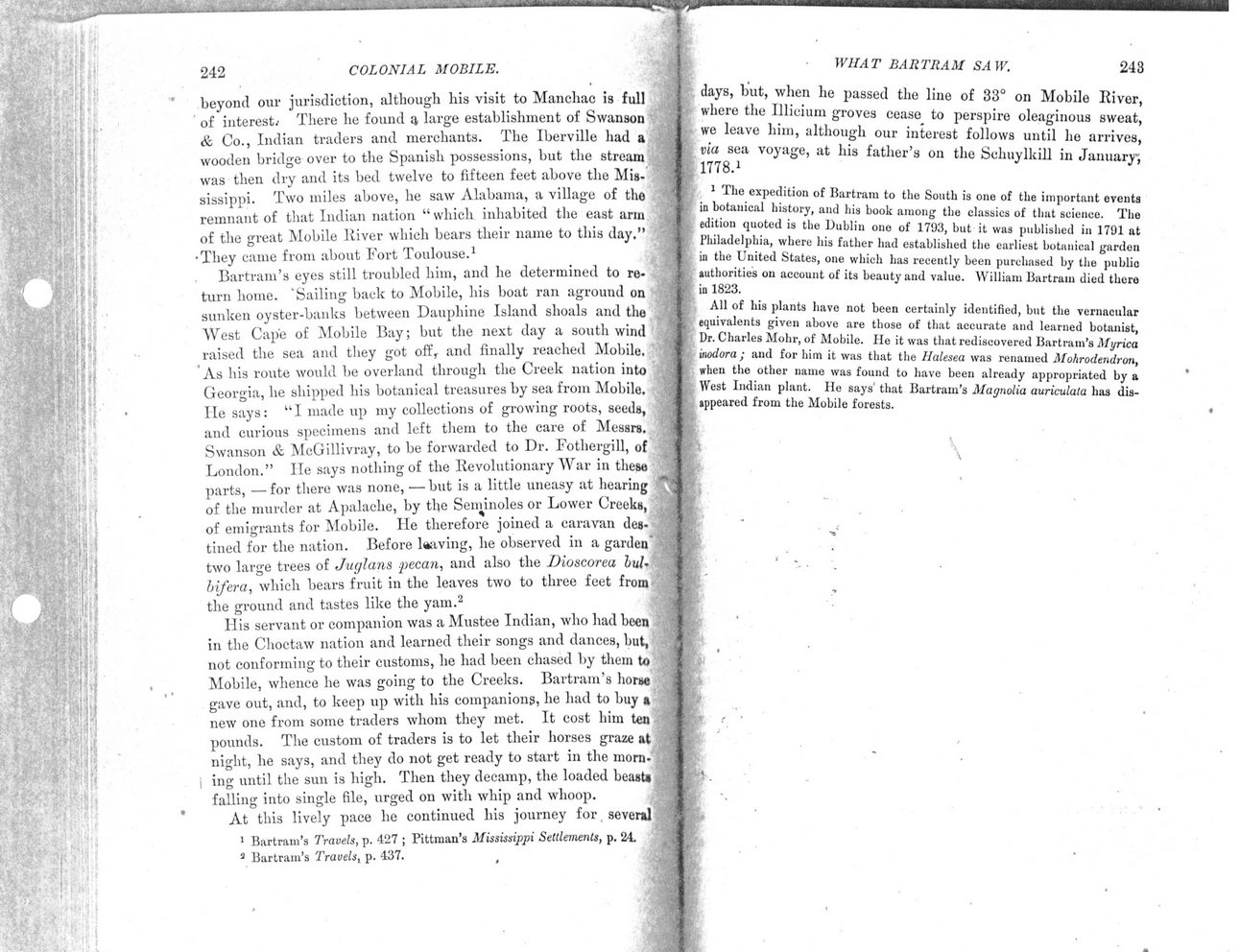This text was obtained via automated optical character recognition.
It has not been edited and may therefore contain several errors.
242 COLONIAL MOBILE. WHAT BARTRAM SAW. 243 "Jt, days, but, when lie passed the line of 33? on Mobile Iliver, beyond our jurisdiction, although his visit to Mancliac is full w , of interest/ There he found q, large establishment of Swanson H If where tlle Illicium groves cease to perspire oleaginous rwm7 - " ' ? 11 mi T1 - ^ ?*-' we leave him. nltWo-1, ...... & Co., Indian traders and merchants. The Iberville had a wooden bridge over to the Spanish possessions, but the stream * was then dry and its bed twelve to fifteen feet above the Mis-fe sissippi. Two miles above, he saw Alabama, a village of the ? remnant of that Indian nation ? which inhabited the east arm of the great Mobile l?iver which bears their name to this day." f-? ?They came from about Fort Toulouse.1 Bartram?s eyes still troubled him, and he determined to re- ^ turn home. ?Sailing back to Mobile, his boat ran aground on 4 sunken oyster-banks between Daupliine Island shoals and the W West Cape of Mobile Bay; but the next day a south wind raised the sea and they got of?r and finally reached Mobile. As his route would be overland through the Creek nation into -v Georgia, he shipped his botanical treasures by sea from Mobile, % He says: ?I made up my collections of growing roots, seeds, and curious specimens and left them to the care of Messrs. 3: Swanson & McGillivray, to be forwarded to Dr. Fothergill, of Is London.? lie says nothing of the Revolutionary War in these ^ parts, ? for there was none, ?? but is a little uneasy at hearing of the murder at Apalache, by the Seminoles or Lower Creeks, of emigrants for Mobile. He therefore joined a caravan des- -M tined for the nation. Before living, he observed in a garden'"^ two large trees of Juglans pecan, and also the Dioscorea lul- arrives, - * ? ? we leave him, although our interest follows until he > via sea voyage, at his father?s on the Schuylkill in Januaryv, i-1778.1 ? 1 The expedition of Bartram to the South is one of the important events I in botanical history, and his hook among the classics of tlmt science. The | edition quoted is the Dublin one of 1793, but it was published in 1791 at * Philadelphia, where his father had established the earliest botanical garden ?; in the United States, one which has recently been purchased by the publio J mthorities on account of its beauty and value. William Bartram died there \ in 1823. | All of his plants have not been certainly identified, but the vernacular * equivalents given above are those of that accurate and learned botanist, J? Dr. Charles Mohr, of Mobile. He it was that rediscovered Bartram?s Myrica Jinodora; and for him it was that the Halesea was renamed Mohrodendron, f when the other name was found to have been already appropriated by a ^ West Indian plant. He says' that Bartram?s Magnolia auriculata has dis-; appeared from the Mobile forests. bifera, which bears fruit in the leaves two to three feet from -M: the ground and tastes like the yam. His servant or companion was a Mustee Indian, who had been in the Choctaw nation and learned their songs and dances, but,? V? not conforming to their customs, he had been chased by them to Ml f Mobile, whence he was going to the Creeks. Bartram?s horue ????'4. gave out, and, to keep up with his companions, he had to buy a new one from some traders whom they met. It cost him ten ; pounds. The custom of traders is to let their horses graze at |5, night, he says, and they do not get ready to start in the morning until the sun is high. Then they decamp, the loaded beast* falling into single file, urged on with whip and whoop. i At this lively pace he continued his journey for several 1 Bartram?s Travels, p. 427 ; Pittman?s Mississippi Settlements, p. 24. 3 Bartram?s Travelsl p. 437.

Bartram Colonial-Mobile-What-Bartram-Saw-p.-242-243